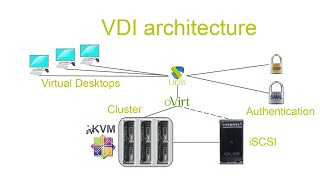As for the storage, they have chosen one of the most economical options: iSCSI with NL-SAS drives, which is much cheaper than purchasing, for example, a Fibre Channel array. In addition, using Blades with CentOS operating systems allows to save costs in hypervisor because it is compatible with the Open Source KVM hypervisor.
They consolidation of the savings is achieved thanks to an Open Source orchestrator supported by Red Hat: oVirt, which is responsible for talking with the hypervisors to distribute and launch the virtual machines, the clones … The University of Sevilla chose oVirt “because UDS Enterprise is certified to work with it”, explains Ramón Gómez, one of the technicians who leads the project.
The choice of UDS Enterprise is based in the fact that it “works in a very coordinated way with the universities and it adapts itself to our needs,” Gómez says. Moreover, a part of its code is released and in order to obtain support, patches and updates you only have to pay a very economic subscription. In fact, there are special prices for university environment.
UDS Enterprise is responsible for serving the virtual desktops to end users. This connection broker controls, authenticates and authorizes users and serves them different virtual machines according to the type of user. It communicates with the main hypervisors in the market ( VMware vSphere, Microsoft Hyper-V, Citrix XenServer, Red Hat KVM, oVirt KVM ), allows the use of multiple authentication systems, such as Active Directory, LDAP, OpenLDAP, eDirectory, SAML, CAS … and connection protocols like RDP, RGS, XRDP, NX, Spice…
This software talks to oVirt through a REST Api to know where the virtual machines are physically running. As for oVirt, it is responsible for orchestrating the virtual machines and it facilitates its management through a management and reporting dashboard.
For further information on this architecture, you can watch the presentation in Spanish conducted by the University of Seville team responsible for the project at the XXV RedIRIS Technical conference 2014 (minute 5).








0 Comments